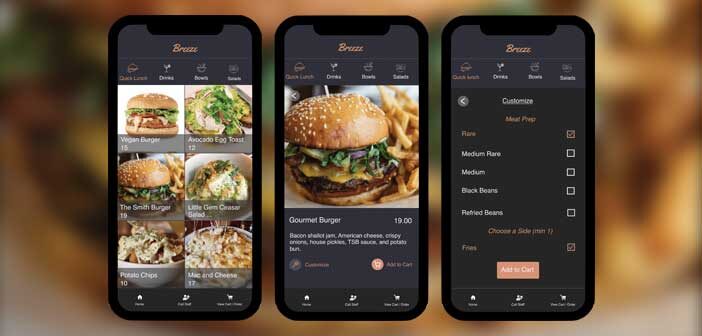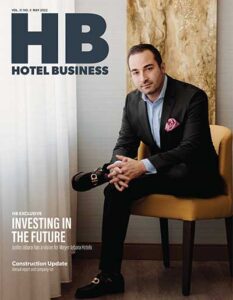Breeze is changing the way hotels offer room service via its QR-code menu platform, which displays an easy-to-order menu with high-quality images of all of the F&B offerings. Properties with or without on-site restaurants can use the platform since Breeze can link to menus from in-house F&B outlets or offer menu items from local, third-party room-service providers. No app download is required.
According to Stefan Kouumdjiev, cofounder, Breeze Technologies, the platform became a room-service disruptor by accident.
“When we first launched, we were primarily working with restaurants and quick-service venues that wanted to make ordering and paying more efficient,” he said. “One day, we were setting up Breeze at a hotel restaurant and noticed that the staff was struggling with room-service orders because they did not have enough people to process them. They told us it would be great if they could also use our platform for room service.”
He added that after talking to some other hotels, he realized that there had been no other smartphone-based ordering platforms designed for room service.
There are benefits for both hotels that have on-site restaurants, and those that don’t. For those with dining establishments, Kouumdjiev noted, “Breeze helps by raising room-service volumes. Guests order more room service with Breeze because it gives them a much simpler and more convenient way to browse the menu and send orders. That’s why we have seen a 20%+ spike in room-service volumes at hotels that adopted Breeze.”
Hotels without a kitchen or restaurant are able to offer a “room-service experience” without having to build out an in-house F&B operation. “This makes hotels stand out on booking sites and improve guest loyalty,” said Kouumdjiev.
Breeze also allows the hotel to reduce the number of random delivery drivers that come in and out, which can improve safety for guests and staff.
“Guests order lots of delivery at hotels that don’t have F&B on-premise, and this brings lots of delivery people into the hotel,” said Kouumdjiev. “That is burdensome for the front-desk staff because they have to vet every deliverer. Oftentimes, the front desk is too busy to vet everyone, especially if there are numerous deliverers in the lobby. So, inevitably, the front-desk staff will often send the deliverers up without calling the guest to verify the order. This shortcut is understandable, especially in light of today’s staff shortages, but it can be discomforting and unsafe.
“By contrast, all Breeze orders are delivered by the same person, who has a special ID badge and is known to the hotel staff,” he continued. “So, when hotels begin using our system, they see fewer strangers coming in and out of their lobbies, and the burden on the front-desk staff becomes lightened.”
The Breeze QR codes are usually given to the guest upon check-in, together with their room key, according to Kouumdjiev, while in some properties, there are also QR codes on table tents in the guestrooms.
Hotels with their own kitchen or restaurant keep all the revenue from Breeze orders, he said, adding, “We simply charge the guest a $1 fee for every transaction, but we do not take a cut of the check. Some of our clients absorb the fee on behalf of the guest, while others let the guest pay it.”
Third-party room-service transactions are handled differently. “The food is prepared by our partner restaurants/ghost kitchens, and they usually keep 85% of the revenue, while the remainder is collected by Breeze,” he said. “In some cases, for larger hotels within certain locations with high volumes, we share a portion of that commission with the hotel. But, these agreements vary case by case and are not standard across the board.”
Thirty-party restaurants and ghost kitchens on the Breeze platform are selected based on three criteria: food quality, cuisine and operational setup.
“To ensure food quality, we consider restaurant reviews, and our team also personally vets the food by actually trying it—that’s one of the most fun aspects of our job,” said Kouumdjiev. “When selecting cuisine, we consider the guest’s preferences and often inquire about the type of delivery they tend to order. If 90% of guests get pizza when ordering delivery, we will partner with a pizzeria. Regarding operational setup, we talk extensively with the restaurant owners to understand their staffing status, how many delivery drivers they have and how far they are located from the hotel. The goal with this criteria is to ensure that the restaurant can handle the volume and prepare the food quickly enough for the guests to be satisfied with the speed.”
Breeze has more than 25 clients, with more coming soon. Many of these properties are in New York City, including the Wyndham Times Square, Even Hotels Midtown West and the Aloft New York LaGuardia Airport. “We are also launching in Ohio at a franchise operator that runs Sleep Inn hotels,” he said.
The Paul Hotel in Manhattan is also a client. “We chose Breeze because their system was very convenient and presents the menu very nicely,” said Mohan Ahluwalia, the hotel’s manager. “We wanted to give our guests convenient options for ordering food. The guests really like the pictures on the menu and how simply everything works.”
He added, “The team in our hotel has also appreciated it because guests constantly ask us for food recommendations. We don’t mind offering recommendations, but it can be repetitive and takes time, and we don’t always have the capacity to provide detailed explanations to our guests. The Breeze team was also very easy to work with and very helpful whenever we wanted changes to the menu and when we needed their help for setup.”
Kouumdjiev and his team are constantly working on adding new features to Breeze, including poolside and beach ordering solutions for resorts. “The idea is to let guests scan a QR code and order from the pool/beach without getting up and walking to the bar or restaurant,” he said. “We are also planning to implement Breeze at events, conferences and conventions.”



